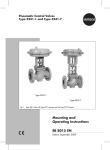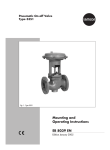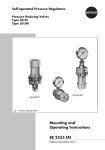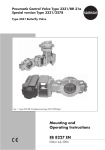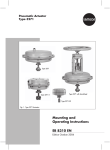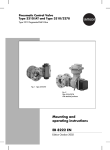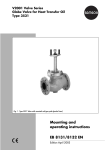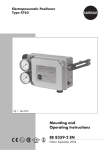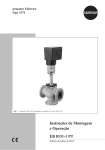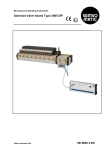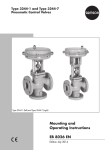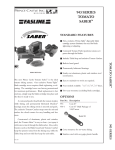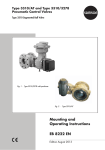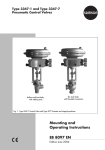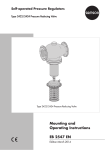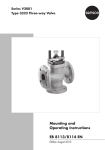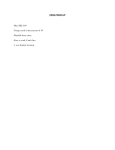Download Mounting and Operating Instructions EB 8093 EN
Transcript
Pneumatic Control Valves Type 3248-1 and Type 3248-7 Fig. 1 · Type 3248 as globe valve and angle valve, both with Type 3277 Pneumatic Actuator Mounting and Operating Instructions EB 8093 EN Edition December 2010 Contents Contents Page 1 Design and principle of operation. . . . . . . . . . . . . . . . . . . . 4 2 2.1 2.2 Assembling and adjusting valve and actuator . . . . . . . . . . . . . . . 6 Option to pretension the springs for actuator version "Actuator stem extends" . . . . . . . . . . . . . . . . . . . . . . . . . 7 Valve and actuator that have different rated travels. . . . . . . . . . . . 8 3 3.1 3.2 Installation . . . . . . . . . . . . . . . . . . . . . . . . . . . . . . . 8 Mounting position. . . . . . . . . . . . . . . . . . . . . . . . . . . . 8 Signal pressure line . . . . . . . . . . . . . . . . . . . . . . . . . . . 8 4 Operation . . . . . . . . . . . . . . . . . . . . . . . . . . . . . . . 9 5 5.1 Maintenance . . . . . . . . . . . . . . . . . . . . . . . . . . . . . . 9 Replacing packing, seat and plug . . . . . . . . . . . . . . . . . . . 10 6 Protective cover . . . . . . . . . . . . . . . . . . . . . . . . . . . . 12 7 Customer inquiries . . . . . . . . . . . . . . . . . . . . . . . . . . 14 Note: Non-electrical actuators and valves do not have their own potential ignition source according to the risk assessment in the rare incident of an operating fault, corresponding to EN 13463-1: 2001 paragraph 5.2, and therefore do not fall within the scope of the European Directive 94/9/EC. Refer to paragraph 6.3 of EN 60079-14:1977 (VDE 0165 Part 1) concerning connection to the equipotential bonding system. 2 EB 8093 EN Safety instructions General safety instructions 4 The control valve must only be mounted, started up or serviced by fully 4 4 4 4 trained and qualified personnel, observing the accepted industry codes and practices. Make sure employees or third persons are not exposed to any danger. All safety instructions and warnings in these mounting and operating instructions, particularly those concerning assembly, start-up and maintenance, must be observed. The control valves fulfill the requirements of the European Pressure Equipment Directive 97/23/EC. Valves with a CE marking have a declaration of conformity that includes information about the applied conformity assessment procedure. The corresponding declaration of conformity can be viewed and downloaded on the Internet at http://www.samson.de. For appropriate operation, make sure that the control valve is only used in areas where the operating pressure and temperatures do not exceed the operating values which are based on the valve sizing data submitted in the order. The manufacturer does not assume any responsibility for damage caused by external forces or any other external influence! Any hazards which could be caused in the control valve by the process medium, operating pressure, signal pressure or by moving parts are to be prevented by means of the appropriate measures. Proper shipping and appropriate storage of the control valve are assumed. CAUTION! 4 For installation and maintenance work on the valve, make sure the relevant 4 4 section of the pipeline is depressurized and, depending on the process medium, drained as well. If necessary, allow the control valve to cool down or warm up to reach ambient temperature prior to starting any work on the valve. Prior to performing any work on the valve, make sure the supply air and control signal are disconnected or blocked to prevent any hazards that could be caused by moving parts. Special care is needed for pneumatic control valves when the actuator springs are pretensioned. These actuators are labeled correspondingly and can also be identified by three long bolts protruding from the bottom of the actuator. Prior to starting any work on the control valve, relieve the compression from the pretensioned springs. EB 8093 EN 3 Design and principle of operation of The test connection (42) allows the pressure to be monitored in order to check the metal bellows for leakage. The Type 3248 Cryogenic Valve can be combined with either a Type 3271 or a Type 3277 Pneumatic Actuator with integral positioner attachment. The process medium flows through the valve in the direction indicated by the arrow. The position of the plug (5) is determined by changes in the signal pressure acting on the actuator diaphragm. 1 Design and operation principle The globe-pattern or angle-pattern valve body is designed for welding in vacuum-insulated pipelines or for installation in cold-box applications. The cryogenic extension bonnet consists of a metal bellows located directly above the valve body and the insulating section above the bellows seal. The plug stem extension consists of a spacer stem (71) and bellows stem (37). The stem extension is connected by the stem connector (A.51) to the actuator stem (A.7). The plug stem is sealed by the metal bellows and the backup packing(15) with spring-loaded PTFE-carbon V-ring packing (Fig. 6). 14 Fig. 2 · Type 3248 as angle valve in aluminum 4 EB 8093 EN Fig. 3 · Valve bonnet with Type 3277 Actuator Design and principle of operation A.1 A.9 A.7 A.51 84 2 32 33 95.9 95 95.2 Legend 1 1.2 Valve body Cryogenic extension bonnet 2 Valve bonnet 4 5 Seat Plug 8 Threaded bushing 9 10 8 15 17 9 10 Stem connector nut Lock nut 15 Packing 17 24 Gasket Guide bushing 42 43 30 Washers 71 32 33 Studs Nuts for studs 35 Nut for guide bushing 37 Bellows stem with metal bellows 37.2 Seal (for metal sealing) 37 41 37.2 30 1.2 35 24 5 4 1 41 42 43 71 84 95 95.2 95.9 Bellows nut Test connection Flat gasket Spacer stem Travel scale indicator Protective cover Adjustment bolt for protective cover Spacer sleeve/washer A.1 A.7 A.9 A.51 Actuator Actuator stem Annular ring Stem connector Fig. 4 · Type 3248-1: Type 3248 Globe Valve with Type 3271 Pneumatic Actuator EB 8093 EN 5 Assembling and adjusting valve and actuator Fail-safe position: Depending on how the springs are arranged in the actuator, the control valve assumes one of two different fail-safe positions: Actuator stem extends: When the pressure is relieved or the supply air fails, the actuator springs move the actuator stem downwards and close the valve. Actuator stem retracts: When the pressure is relieved or the supply air fails, the actuator springs move the actuator stem upwards and open the valve. 2 Assembling and valve and actuator adjusting If the valve and actuator have not been preassembled by the manufacturer or in the case that the original actuator attached to the valve is to be replaced by another actuator of a different type or size, proceed as follows: Removing a mounted actuator Note: For actuators with fail-safe action "Actuator stem extends" and especially actuators with pretensioned springs, apply a pressure slightly higher than the lower bench range (see actuator nameplate) to the loading pressure connection on the bottom diaphragm chamber before undoing the annular nut (A.9). 4 Remove clamps of the stem connector 4 (A.51) between the actuator stem and spacer stem and unscrew annular nut (A.9). Lift the actuator (A.1) off the valve. Mounting the actuator 1. Loosen the lock nut (10) and stem connector nut (9) on the valve. Firmly press the plug (5) with the plug stem into the seat (4). Then thread down the lock nut and stem connector nut. 2. Remove clamps of the stem connector (A.51) and annular nut (A.9) on the actuator (A.1). Fig. 5 · Valve bonnet with yoke (PN 100/Class 600) 6 EB 8093 EN Assembling and adjusting valve and actuator 3. Slide the annular nut over the spacer stem (71). 4. Place the actuator on the valve bonnet (2) and screw tight using the annular nut (A.9). 5. Read the nameplate on the actuator to determine which bench range (signal range with pretensioned springs) and which fail-safe are used. The fail-safe action "Actuator stem extends" or "Actuator stem retracts" is indicated on the nameplate by FA or FE respectively on the Type 3271 Actuator and by the appropriate symbol on the Type 3277 Actuator. The lower bench range corresponds to the lower signal pressure range to be adjusted, while the upper bench range corresponds to the upper signal pressure range. 6. For actuators with fail-safe action "Actuator stem extends", apply the pressure corresponding to the lower signal pressure range (e.g. 0.2 bar) to the loading pressure connection on the bottom diaphragm chamber. For actuators with fail-safe action "Actuator stem retracts", apply the pressure corresponding to the upper signal pressure range (e.g. 1 bar) to the loading pressure connection on the top diaphragm chamber. 7. Thread on the stem connector nut (9) by hand until it touches the actuator stem (A.7) and then turn it a further ¼ turn. Secure this position with the lock nut (10). 8. Position clamps of the stem connector (A.51) and fasten tight. 9. Align travel indicator scale (84) with tip of the stem connector; for actuators with "Actuator stem extends" align it with lower marking (valve closed) and for actuators with "Actuator stem retracts" align it with top marking (valve open). 2.1 Option to pretension the springs for actuator version "Actuator stem extends" To achieve a greater thrust, the actuator springs can be pretensioned by 12.5 % (240 cm²), by 25 % (350 and 700 cm²) or by 75 % (700 cm²) of their travel or their bench range. If, with a bench range of 0.2 to 1 bar, the springs are to be pretensioned by 0.1 bar, for example, the bench range is shifted by 0.1 bar to 0.3 bar. When adjusting the valve, a signal pressure of 0.3 bar is to be set as the lower signal pressure range. The new bench range of 0.3 to 1.1 bar must be marked on the nameplate as the bench range with pretensioned springs. EB 8093 EN 7 Installation 2.2 Valve and actuator that have different rated travels Actuators with springs that have already been pretensioned by the manufacturer without attachment to a valve are marked by an appropriate label. In addition, such actuators can be identified by three bolts protruding from the bottom diaphragm case which allow the spring compression to be unloaded evenly before removing the actuator from the valve. 3 Installation 3.1 Mounting position The valve can be mounted in any position. It must be installed free of tension. If necessary, supports can be mounted on the pipelines near the connections. If an actuator with a side-mounted handwheel is installed at an angle less than 45° to the horizontal, the actuator must be additionally supported. CAUTION! Prior to welding the valve body into the pipeline, apply air pressure for valves with fail-safe action “Actuator stem extends” (valve closed) to move the valve plug out of the seat. This prevents the trim from being damaged by excessive high temperatures. Note: Remove the stopper from the test connection (42) to allow the metal bellows (37) to be monitored for leakage. 3.2 Signal pressure line Connect the signal pressure line for valves with fail-safe action "Actuator stem extends" to the loading pressure connection on the bottom diaphragm case, and for valves with fail-safe action "Actuator stem retracts" to the loading pressure connection on the top diaphragm case. The lower connection of Type 3277 Actuator is located on the yoke at the bottom diaphragm case. 8 EB 8093 EN Operation 4 Operation To reverse the direction of action, refer to Mounting and Operating Instructions of the respective pneumatic actuator: EB 8310 EN for Type 3271 EB 8311 EN for Type 3277 5 Note: Seat wrenches can be ordered using the following order numbers: For DN 15 to 150: Complete set 1280-3047 For DN 15 and 25: Single set 1280-3073 Maintenance If leakage occurs, this could be caused by a damaged metal bellows (37) or a defective packing (15). If the valve does not seal properly, the tight shut-off may be impeded by dirt or other impurities caught between the seat and plug, or by damaged facings. Remove the parts, clean them thoroughly and replace them with new ones, if necessary. Before servicing or disassembling the control valve, depressurize the relevant section of the plant and drain it. Wait until the medium has reached ambient temperature, if necessary. As valves are not free of cavities, there might still be residual medium in the valve. We recommend removing the valve from the pipeline or the entire valve assembly when the valve is welded in the pipeline. On performing any work on the valve body, first shut off the supply pressure, disconnect the supply pressure line and remove the actuator. EB 8093 EN 9 Maintenance 5.1 Replacing packing, seat and plug washer (12), and spring (11). Replace damaged parts with new ones. Carefully clean the packing chamber. Removing the actuator Prior to performing any work on the valve body, remove the actuator first. Note: For actuators with fail-safe action "Actuator stem extends" and especially actuators with pretensioned springs, apply a pressure slightly higher than the lower bench range (see actuator nameplate) to the loading pressure connection on the bottom diaphragm chamber before undoing the annular nut (A.9). 1. Remove clamps of the stem connector (A.51) between actuator stem and spacer stem and unscrew annular nut (A.9). 2. Lift the actuator off the valve. Plug 1. Unscrew spacer stem (71). 2. Use a SAMSON socket wrench to unscrew the bellows nut (41). Pull out the bellows stem together with the metal bellows (37), guide bushing (24) and plug (5) from the cryogenic extension bonnet (1.2). 3. Use a suitable tool to clamp the bellows stem (37) tightly. 4. Unthread the plug from the bellows stem. 5. Loosen nut (35). Unscrew guide bushing (24). In the case of large nominal sizes, unscrew second nut and remove guide bushing. Packing (Fig. 6) 8 1. Unscrew the stem connector nut (9) and lock nut (10). 2. Undo threaded bushing (8) to relieve the tension from the packing (15). 3. Unthread the nuts (33) at the valve bonnet. Lift valve bonnet upwards off the flanged section of the cryogenic extension bonnet (1.2). 4. Unthread threaded bushing (8) and use a suitable tool to remove the packing (15) including the packing rings (16), 2 16 10 EB 8093 EN 12 11 71 Fig. 6 · Packing 15 Maintenance Note: There is no guide bushing in valve sizes NPS 4 and 6/Class 150 and 300 with reduced overall height. 6. Apply lubricant (order no. 8150-0116) to the plug stem thread of the new or original plug that has been machined. 7. Screw guide bushing (24) onto the bellows stem as far as it will go. Lock into position with the nut (35) or slide on the guide bushing and fasten with two nuts. 8. Replace old washers (30) with new ones. Screw the plug stem tightly into the bellows stem. Tightening torque: 50 Nm for DN 25 to 80 (NPS 1 to 3) 140 Nm for DN 100 to 150 (NPS 4 to 6). Seat If the seat must also be replaced, proceed as follows: 9. Use a SAMSON seat wrench to unscrew the seat (4) out of the valve body. 10. Apply lubricant (order no. 8150-0116) to the seat thread of the new seat and screw in tightly observing the tightening torques in Table 1. Assembly 1. Slide bellows stem together with metal bellows (37), guide bushing (24) and plug into the body. 2. Insert bellows nut (41) and screw tight. Screw spacer stem onto the bellows stem (observing tightening torques in Table 1). 3. Insert new gasket (17) into the flanged section. Slide valve bonnet over the spacer stem and place it on the flanged section. 4. Thread on nut (33) and screw tight, observing the tightening torques in Table 1. 5. Apply lubricant (order no. 8150-0116) to packing parts and threaded bushing (8). Slide spring (11), washer (12) and new packing rings (16) over the spacer stem into the packing chamber. Put on threaded bushing (8) and tighten it as far as it will go. Table 1 · Tightening torques in Nm for steel and aluminum versions Nominal size DN NPS Body nuts (33/14) Seat (4, material) CrNiMo Stellite 2.4610 2.4819 2.4360 Bellows nut (41) Globe valve (33) PN 40 Cl 300 PN 100 Cl 600 Aluminum angle valve (14) Spacer stem (71) 15...25 ½ ...1 160 170 130 200 40 50 30 30 32...50 1½ ...2 480 500 380 1000 80 80 40 30 65...80 2½ ...3 900 1050 800 2000 150 110 60 30 100 4 1250 1550 1150 3200 130 150 100 40 150 6 2300 2600 2000 3840 130 190 120 40 EB 8093 EN 11 Protective cover 6. Screw the lock nut (10) and nut (9) loosely onto the spacer stem (71). 7. Mount actuator and adjust the lower or upper bench range as described in section 2. 6 Protective cover To keep the overall height of the valve as small as possible for transportation purposes in cold-box installations, the actuator and valve bonnet must be removed from the flanged section of the cryogenic extension bonnet and the bellows stem protected by a protective cover. General The protective cover with adjustment bolt must meet the following requirements when the valve is installed in the plant: 4 Opening the valve to its rated travel to 4 allow the pipeline and the valve to be rinsed. Closing the valve to perform a pressure test (to check the tightness of the plant section). The bellows seal in this case is the primary sealing element. The protective cover merely serves to transfer the force. Description of the function In the delivered state, the protective cover is mounted and the valve is open (the thread of the bellows stem is completely screwed into the adjustment bolt). To perform the leak test in the plant section, the adjustment bolt must be threaded counterclockwise (valve closed). linksdrehen zum Schließen/ counter clockwise to close 95.3 95.4 MA 32 33 95.9 95.1 95.7 42 95.5 43 95.6 95.2 37 F Fig. 7 · Protective cover 12 EB 8093 EN Schließkraft/ closing force Legend 32 Stud 33 Nut 37 Bellows stem with metal bellows 42 Test connection 43 Flat gasket 95.1 Protective cover 95.2 Adjustment bolt (SW 19) 95.3 Retaining ring 95.4 O-ring 95.5 Screw plug 95.6 Flat gasket 95.7 O-ring 95.9 Spacer sleeve/ washer Protective cover If the adjustment bolt is turned clockwise, the plug is lifted out of the seat (valve opens). Mounting the protective cover Note: For actuators with fail-safe action "Actuator stem extends" and especially actuators with pretensioned springs, apply a pressure beforehand to retract the actuator stem slightly. 1. Remove the mounted actuator as described in section 2. 2. Detach the spacer stem (71) from the bellows stem (37) by unscrewing the stem connector nut and lock nut. 3. Remove the nuts (33) on the valve bonnet. Carefully lift off the valve bonnet (2) including the spacer stem from the flanged section of the cryogenic extension bonnet (1.2). 4. Align the protective cover with stuck-on O-ring (95.7) onto the studs (32). 5. Place the protective cover with adjustment bolt (95.2) on the thread of the bellows stem (37). 6. Turn the adjustment bolt (SW 19) clockwise until the protective cover (95.1) is seated on the flange. 8. Fasten tight the studs (32) with nuts (33) and spacer sleeves/washers (95.9). Removing the protective cover 1. Remove the nuts (33) and washers/spacer sleeves (95.9). 2. Turn the adjustment bolt (95.2) counterclockwise. The plug is lowered and the protective cover is lifted off the flange. 3. After reaching the threaded end of the bellows stem (37), remove the protective cover. 4. Use the nuts (33) to mount the actuator! The washers/spacer sleeves (95.9) are no longer required. Mounting the valve bonnet with spacer stem 1. Insert a new gasket (17) into the body flange. 2. Place the valve bonnet (2) with spacer stem (71) onto the body flange. To do so, place the spacer stem over the thread of the bellows stem (37) and hand tighten. While doing so, do not change the position of the stem connector nut (9) or the lock nut (10) on the spacer stem! 3. Tighten the nuts (33) on the studs (32) in a criss-cross pattern using the torque listed in Table 1. 4. Use the stem connector nut (9) to fasten tight the spacer stem (71) and the bellows stem (37) using the torque listed in Table 1. 5. Check whether the threaded bushing (8) is tightened as far as it will go. 6. Mount the actuator. If the position of the stem connector nut and lock nut has not changed while the EB 8093 EN 13 Customer inquiries valve bonnet was removed, the bench range is still correct and does not need to re-adjusted. When the stem connector nut and lock nut have been removed, the spacer stem can also be tightened over its hexagonal end. Further information Further information, e.g. required tightening torques, can be found in the special documentation TV-SK 9626. 7 Customer inquiries Please submit the following details: 4 Type designation and order number (on nameplate) 4 Serial number, nominal size and version of the valve 4 Pressure and temperature of the process medium 4 Flow rate in m³/h 4 Bench range (spring range) (e.g. 0.2 to 1 bar) of the actuator 4 Installation drawing Dimensions Refer to the Data Sheet T 8093 EN for the dimensions and weights of the various valve versions. 14 EB 8093 EN EB 8093 EN 15 EB 8093 EN S/Z 2011-01 SAMSON AG · MESS- UND REGELTECHNIK Weismüllerstraße 3 · 60314 Frankfurt am Main · Germany Phone: +49 69 4009-0 · Fax: +49 69 4009-1507 Internet: http://www.samson.de
















